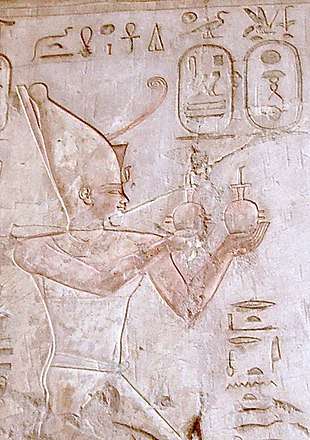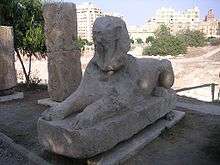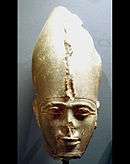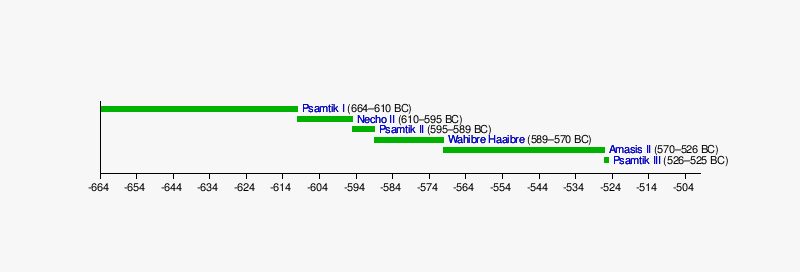Twenty-sixth Dynasty of Egypt
Egypt | |||||||||
|---|---|---|---|---|---|---|---|---|---|
| 664 BC–525 BC | |||||||||
| Capital | Sais | ||||||||
| Common languages | Egyptian language | ||||||||
| Religion | Ancient Egyptian religion | ||||||||
| Government | Monarchy | ||||||||
| Pharaoh | |||||||||
• 664–610 BC | Psamtik I (first) | ||||||||
• 526–525 BC | Psamtik III (last) | ||||||||
| History | |||||||||
• Established | 664 BC | ||||||||
• Disestablished | 525 BC | ||||||||
| |||||||||
The Twenty-sixth Dynasty of Egypt (notated Dynasty XXVI, alternatively 26th Dynasty or Dynasty 26) was the last native dynasty to rule Egypt before the Persian conquest in 525 BC (although others followed). The dynasty's reign (664–525 BC) is also called the Saite Period after the city of Sais, where its pharaohs had their capital, and marks the beginning of the Late Period of ancient Egypt.[1]
History
This dynasty traced its origins to the Twenty-fourth Dynasty. Psamtik I was probably a descendant of Bakenranef, and following the Neo-Assyrian Empire's invasions during the reigns of Taharqa and Tantamani, he was recognized as sole king over all of Egypt. While the Neo-Assyrian Empire was preoccupied with revolts and civil war over control of the throne, Psamtik threw off his ties to the Assyrians circa 655 BC, formed alliances with King Gyges of Lydia, and recruited mercenaries from Caria and ancient Greece to resist Assyrian attacks.
With the sack of Nineveh in 612 BC and the fall of the Assyrian Empire, both Psamtik and his successors attempted to reassert Egyptian power in the Near East, but were driven back by the Neo-Babylonian Empire under Nebuchadnezzar II. With the help of Greek mercenaries, Apries was able to hold back Babylonian attempts to conquer Egypt, only for the Persians to eventually do so. Their king, Cambyses II, captured and later executed Psamtik III.
Art
 Pottery vessel showing the face of god Bes, from the 26th Dynasty. The Petrie Museum of Egyptian Archaeology, London
Pottery vessel showing the face of god Bes, from the 26th Dynasty. The Petrie Museum of Egyptian Archaeology, London Female figure, Louvre Museum. The name of Psamtik I is inscribed under the feet.
Female figure, Louvre Museum. The name of Psamtik I is inscribed under the feet.
Pharaohs of the 26th Dynasty
The 26th Dynasty may be related to the 24th Dynasty. Manetho begins the dynasty with:
- Ammeris the Nubian, 12 (or 18) years
- Stephinates, 7 years
- Nechepsos, 6 years
- Necho, 8 years.
When the Nubian King Shabaka defeated Bakenranef, son of Tefnakht, he likely installed a Nubian commander as governor at Sais. This may be the man named Ammeris. Stephinates may be a descendant of Bakenrenef. He is sometimes referred to as Tefnakht II in the literature. Nechepsos has been identified with a local king named Nekauba (678–672 BC). Manetho's Necho is King Necho I (672–664 BC); Manetho gives his reign as 8 years.[2] Necho was killed during a conflict with the Nubian king Tantamani. Psamtik I fled to Nineveh – capital of the Neo-Assyrian Empire – and returned to Egypt when Ashurbanipal defeated Tantamani and drove him back south.[1] Scholars now start the 26th Dynasty with the reign of Psamtik I.[1][2]
Sextus Julius Africanus states in his often accurate version of Manetho's Epitome that the dynasty numbered 9 pharaohs, beginning with a "Stephinates" (Tefnakht II) and ending with Psamtik III. Africanus also notes that Psamtik I and Necho I ruled for 54 and 8 years respectively.
| Name of Pharaoh | Image | Reign | Throne name | Burial | Consort(s) | Comments |
|---|---|---|---|---|---|---|
| Psamtik I/Psammetichus I |  | 664–610 BC | Wahibre | Sais | Mehytenweskhet | Reunified Egypt and ended the Nubian control of Upper Egypt. Manetho gives his reign as 54 years. |
| Necho II |  | 610–595 BC | Wehemibre | Khedebneithirbinet I | Necho II is the Pharaoh most likely mentioned in several books of the Bible. | |
| Psamtik II/Psammetichus II |  | 595–589 BC | Neferibre | Takhuit | ||
| Wahibre Haaibre (Apries) |  | 589–570 BC | Haaibre | Overthrown and forced into exile by Amasis II. Returned to Egypt at the head of a Babylonian army, but was defeated and likely killed. Manetho gives his reign as 19 years. | ||
| Amasis II/Ahmose II | 570–526 BC | Khnem-ib-re | Sais | Tentkheta Nakhtubasterau | Herodotus claims that when Cambyses II invaded Egypt, realizing he was not able to exact revenge for Amasis's previous misdeeds and trickery, he exhumed his body, desecrated it and burned what remained of the mummy. | |
| Psamtik III/Psammetichus III |  | 526–525 BC | Ankhkaenre | Ruled for only 6 months according to Herodotus before a Persian invasion led by Cambyses II. |
Timeline of the 26th Dynasty

See also
References
Bibliography
- Aidan Dodson, Dyan Hilton. The Complete Royal Families of Ancient Egypt. The American University in Cairo Press, London, 2004.
- Kenneth Kitchen, The Third Intermediate Period in Egypt, 1100–650 B.C. (Book & Supplement) Aris & Phillips. 1986 ISBN 978-0-85668-298-8.
- Karl Jansen-Winkeln, Bild und Charakter der ägyptischen 26. Dynastie, Altorientalische Forschungen, 28 (2001), 165–182.
